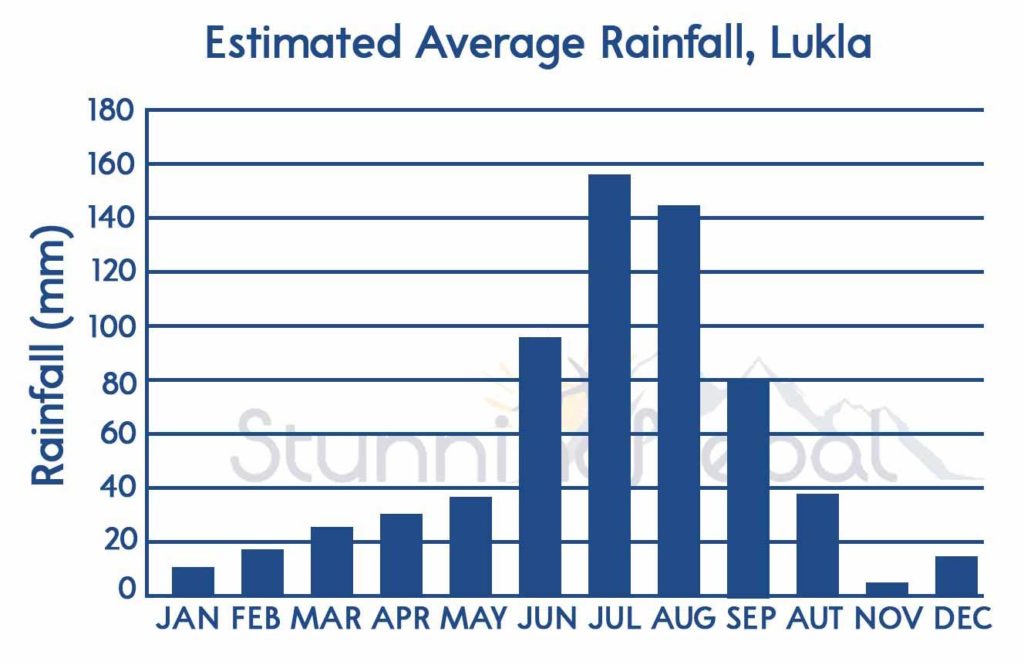Learn about Everest Base Camp Weather and know about the best season to trek the Everest region. Visibility of Mount Everest is best during the Autumn and Spring Seasons as the overall temperature is best for trekking.
While ascending up the mountainous part of Nepal, you will gain a significant altitude. Starting from Kathmandu (the capital city of Nepal) situated at about 1,345 meters, you will gain a total of 4,000 meters before you reach Everest Base Camp at an altitude of 5,550 meters.
So, you will experience variations in weather every day as you head towards Everest Base Camp. The weather turns unpredictable in this trek as you head higher.
Everest Base Camp Weather

As Mt. Everest is covered by snow all year round, the climate for this reason has a big gap between day and night. The temperature is at the plus point as well as minus and beyond zero.
The Everest Base Camp trek’s best time is during the autumn and spring seasons on the basis of ideal weather.
Also Read: Everest Base Camp Trek Tips – 10 Actionable Tips
Best Season for Everest Base Camp Trekking
Each season is different with unique features and challenges that add up to your adventure. You can trek in any season on your preference.
Here, we have detailed the weather condition at Everest Base Camp for four major seasons.

1. Spring (March, April, May)
The Everest region is calm during the spring in terms of climate and is the best season for the Everest Base Camp trek. Spring months in Nepal include March, April, and May.
As it is the best time for EBC trekking, you will find a lot of adventurers from different countries on the trails to Everest Base Camp. The trail is overcrowded during this season and you will get to meet many Everest climbers.
As spring is the season of blossoms, you will enjoy different species of wildflowers along the trail in the lower altitudes. The mountains, glaciers, and quaint villages will bring out the most awesome color during this season.
Blooming rhododendron (the national flower of Nepal) will certainly give you a pleasant feeling. Also, take some time to enjoy the species of rare mountainous birds and animals. You will definitely fall in love with the natural lush in the Sagarmatha National Park.
The average temperature during the day reaches up to 10°C in the lower altitudes and up to a maximum of 17°C during the sunny days at higher altitudes. However, the temperature lowers from -5°C to -15°C in the morning and night.
Your journey will remain fresh in your memory file as photography becomes awesome at Everest Base Camp during the spring.
2. Summer (June, July, August)
In Nepal, the summer months are from June to August. In this season, trekking trails may be wet due to the monsoon. This season is a less favorable time to trek Mount Everest Base Camp in comparison to spring.
There’s a high possibility of a landslide in the lower region and avalanches in the higher altitudes. Moreover, summer is not favorable for observing the panoramic view of the mountains.
However, for an aspiring botanist, it might be the best time to study various species of flora and fauna. Most of the tea shops along the trail remain closed during the time of rainfall. In this season, the trail can be less crowded.
3. Autumn (September, October, November)
September to November is autumn in Nepal. This is the perfect time to trek the Everest Base Camp as the weather is the clearest and most stable. The sky is clear during autumn so, you can enjoy a great view of snowy mountains.
The temperature in autumn is the warmest and is a comfortable time for trekking. So, you will have to deal with the crowd. Though the climate is almost clear, you need to be prepared with proper gear as the weather in the mountain region can’t be predicted.
4. Winter (December, January, February)
From December to February, the northern hemisphere of Nepal remains frozen. The days are shorter and nights are a lot colder. Despite the chilling weather, you can still trek as the climate remains stable and dry during winter.
The temperature at Everest Base Camp during the nighttime can be somewhere between -20 to -3 degrees Celsius. There will be no problem if you choose to stay in a tent at the base camp. Winter can be called off-season to trek Everest Base Camp.
But, it may be the best time for you if you want to avoid the crowd. As most of the tea houses and lodges are vacant during this freezing weather, you will get to enjoy good hospitality and enjoy discounts.
Without a doubt, winter can be the challenging season for EBC trekkers because the trail that goes through the high passes such as the Gokyo trail and Mera peak trail will be closed. Almost all the places will be covered with thick layered snow.
However, a spectacular view of mountains on a clear day will be the best part of your trip. It will definitely be adventurous trekking with a lot of snow and chill.
Recommended Reading: What to wear in Nepal in January?